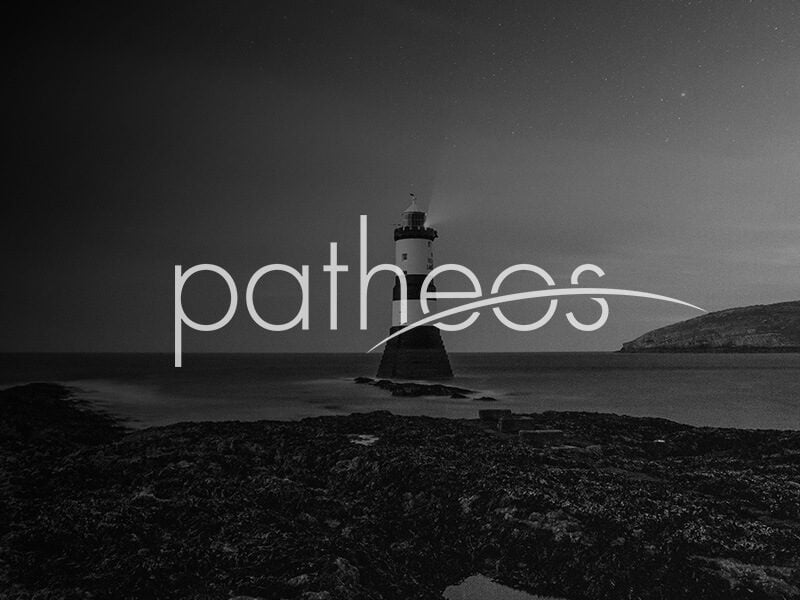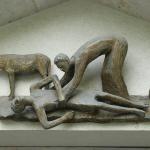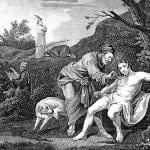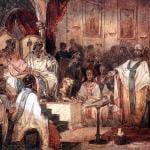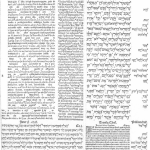Berkeley, Calif., Jun 8, 2016 / 04:23 pm (CNA).- Two minutes and thirty seconds is all it took for Sean Bryan to complete the Los Angeles qualifier round of American Ninja Warrior. The season eight premiere of the hit NBC/Esquire show – which follows competitors as they try to complete obstacles courses of increasing difficulty – featured the amateur flying through every obstacle. He even climbed the newly designed, 14.5-foot Warped Wall on his first try. Bryan claimed 4th place and ranked among the show’s veterans, but something else caught everyone’s attention. On Bryan’s bright, yellow shirt was written: ‘Papal Ninja’. “I thought, how could I be a bit more explicit about my faith,” Bryan told CNA, “because it is quite explicit in my life.” The 31-year-old is an active member of the Catholic Church. His story, and the mystery behind his chosen competition name, were highlighted on American Ninja Warrior this month. <blockquote class="instagram-media" data-instgrm-captioned data-instgrm-version="7" style=" background:#FFF; border:0; border-radius:3px; box-shadow:0 0 1px 0 rgba(0,0,0,0.5),0 1px 10px 0 rgba(0,0,0,0.15); margin: 1px; max-width:658px; padding:0; width:99.375%; width:-webkit-calc(100% - 2px); width:calc(100% - 2px);"><div style="padding:8px;"> <div style=" background:#F8F8F8; line-height:0; margin-top:40px; padding:33.287037037% 0; text-align:center; width:100%;"> <div style=" background:url(data:image/png;base64,iVBORw0KGgoAAAANSUhEUgAAACwAAAAsCAMAAAApWqozAAAABGdBTUEAALGPC/xhBQAAAAFzUkdCAK7OHOkAAAAMUExURczMzPf399fX1+bm5mzY9AMAAADiSURBVDjLvZXbEsMgCES5/P8/t9FuRVCRmU73JWlzosgSIIZURCjo/ad+EQJJB4Hv8BFt+IDpQoCx1wjOSBFhh2XssxEIYn3ulI/6MNReE07UIWJEv8UEOWDS88LY97kqyTliJKKtuYBbruAyVh5wOHiXmpi5we58Ek028czwyuQdLKPG1Bkb4NnM+VeAnfHqn1k4+GPT6uGQcvu2h2OVuIf/gWUFyy8OWEpdyZSa3aVCqpVoVvzZZ2VTnn2wU8qzVjDDetO90GSy9mVLqtgYSy231MxrY6I2gGqjrTY0L8fxCxfCBbhWrsYYAAAAAElFTkSuQmCC); display:block; height:44px; margin:0 auto -44px; position:relative; top:-22px; width:44px;"></div></div> <p style=" margin:8px 0 0 0; padding:0 4px;"> <a href="https://www.instagram.com/p/BGNzFSAPbbk/" style=" color:#000; font-family:Arial,sans-serif; font-size:14px; font-style:normal; font-weight:normal; line-height:17px; text-decoration:none; word-wrap:break-word;" target="_blank">"There's nothing so strong as gentleness, and nothing so gentle as true strength" (#FrancisDeSales). On this feast of the #SacredHeart, #BeCourageous in exercising strength through #mercy. #anw8training #ninjawarrior #anw8 #PapalNinja #firstfriday @franciscus</a></p> <p style=" color:#c9c8cd; font-family:Arial,sans-serif; font-size:14px; line-height:17px; margin-bottom:0; margin-top:8px; overflow:hidden; padding:8px 0 7px; text-align:center; text-overflow:ellipsis; white-space:nowrap;">A photo posted by Sean Bryan (@papalninja) on <time style=" font-family:Arial,sans-serif; font-size:14px; line-height:17px;" datetime="2016-06-04T02:21:06+00:00">Jun 3, 2016 at 7:21pm PDT</time></p></div></blockquote> <script async defer src="//platform.instagram.com/en_US/embeds.js"></script> The show explained Bryan’s history as a gymnast for the University of California, Berkley. While studying physics, Bryan competed mostly on parallel bars and rings. His team earned fifth place in the NCAA championship. It then revealed how Bryan discerned the priesthood with the Salesians of Don Bosco in California. Though Bryan discerned out, the episode showed how he stayed with the Salesians to finish his Masters in Theology with a Salesian Studies Concentration at the Dominican School of Philosophy & Theology. The episode followed Bryan, who has now earned the degree, as he continues to live with the Salesians and help them as an assistant to the director, and special projects manager. He even turned their garage into an American Ninja Warrior training facility. Bryan also owns his own freelance design and videography business and works as the project manager for the Lay Mission Project – an initiative by the Western Dominican province, Diocese of Sacramento, Catherine of Siena Institute, Institute of Salesian Studies, and Our Sunday Visitor – to form lay Catholics ‘for the sake of animating the mission of the Church to secular society.’ “The producers really took a liking to my story and they wanted to focus on the Catholic aspect,” Bryan said. “I totally went along with it because I thought it would be a great idea, because that’s really who I am at heart.” The Papal Ninja was raised Catholic. He grew up in Cranford, New Jersey and attended Catholic schools much of his life. “I didn’t really take faith seriously but I started exploring it the last three years of high school,” he said. Bryan said his faith life changed when the events of 9/11 and a friend’s death unfolded in the same year. With the help of his teachers and a local priest, Bryan was able to process everything and ask questions about the faith. After high school, Bryan attended Temple University. The same local priest that helped guide him in high school encouraged him to go on a retreat. “I decided that no, retreats are for Jesus freaks, so I’ll just start going to Mass.” Over time, Bryan said he started feeling more comfortable in his faith. He was on the gymnastics team at Temple University for two years before transferring to the University of California, Berkeley. “I saw it as a new beginning,” he said. “I made a new commitment to be myself and part of that is to not worry about what people think, to go to Mass, and to take my faith seriously.” When he finally decided to go on a retreat, Bryan said he was asked to help lead it. “I thought, woah, woah, woah, I’ve never been on a retreat before, let alone help lead one.” “That experience of ministering to people,” he said, “to see the reality, how faith is planning out people’s lives, really impacted me.” It was then that Bryan began to discern his vocation and thought God was calling him to the priesthood. “I assumed that if God is giving me the gift of faith to dedicate my life to it, it’s probably the priesthood.” But after four years of formation with the Salesians, before making vows, Bryan decided religious life was not God’s call for him. While at the Dominican School, Bryan said Father Michael Sweeney O.P., the school’s president, helped him appreciate the importance of the lay role in the Church. Bryan began working on the Lay Mission Project. Bryan’s family, friends, young people he mentored, and a few Salesians all watched him train for American Ninja Warrior and gave him advice. During the competition, they cheered him on until he hit the red buzzer. Sharing the moment with his parents, Bryan said, was the most special thing about the whole experience. They traveled from New Jersey to support him. During the course, Bryan said he just took each obstacle as it came and focused on what was next. Throughout training, he would integrate prayer into difficult activities, make the sign of the cross, ask for protections and strength, and pray to St. Frances de Sales for humility. “My friend Francis de Sales keeps me on point with respect to enjoying the process,” he said. When Bryan finished the actual course, he did a backflip and gave God the glory. “I realized, wow this really did just happen,” he said, “I pointed to the heavens thinking to myself, ‘thank you.’” Since the episode aired on June 1, Bryan said he has been receiving positive messages from both believers and non-believers. He said he hopes people see that they too can be alive in their faith and that it is not unusual. <blockquote class="twitter-tweet" data-lang="en"><p lang="en" dir="ltr"><a href="https://twitter.com/hashtag/JustLikeThat?src=hash">#JustLikeThat</a> The <a href="https://twitter.com/hashtag/PapalNinja?src=hash">#PapalNinja</a> has the faith, the action & fastest time of the night so far on <a href="https://twitter.com/hashtag/AmericanNinjaWarrior?src=hash">#AmericanNinjaWarrior</a> <a href="https://twitter.com/hashtag/Awesome?src=hash">#Awesome</a> job!!</p>— TG2 - The Poet (@tg2_thepoet) <a href="https://twitter.com/tg2_thepoet/status/738178204922433536">June 2, 2016</a></blockquote> <script async src="//platform.twitter.com/widgets.js" charset="utf-8"></script> <blockquote class="twitter-tweet" data-lang="en"><p lang="en" dir="ltr"><a href="https://twitter.com/hashtag/papalninja?src=hash">#papalninja</a> got me praying <a href="https://twitter.com/hashtag/AmericanNinjaWarrior?src=hash">#AmericanNinjaWarrior</a></p>— Cassie Reid (@ThisisCassReid) <a href="https://twitter.com/ThisisCassReid/status/738192862739759104">June 2, 2016</a></blockquote> <script async src="//platform.twitter.com/widgets.js" charset="utf-8"></script> <blockquote class="twitter-tweet" data-lang="en"><p lang="en" dir="ltr"><a href="https://twitter.com/PapalNinja">@PapalNinja</a> Love that you're bring God in the convo for American Ninja Warrior! Keep on keeping on 🙂 <a href="https://twitter.com/hashtag/PapalNinja?src=hash">#PapalNinja</a></p>— Maria Gironas (@MariaGironas) <a href="https://twitter.com/MariaGironas/status/738223490180874240">June 2, 2016</a></blockquote> <script async src="//platform.twitter.com/widgets.js" charset="utf-8"></script> “I hope they might be able to see faith as a normal thing,” he said, “as something that doesn’t cast you aside from society, but as a good thing.” When asked about the inspiration behind the Papal Ninja name, Bryan referenced the laity in paragraph 33 of Lumen Gentium, the Dogmatic Constitution on the Church. “The lay apostolate, however, is a participation in the salvific mission of the Church itself. Through their baptism and confirmation all are commissioned to that apostolate by the Lord Himself,” the document says. “We’re all called to be papal ninjas,” Bryan said, “to help accomplish the secular mission of the Church as a lay person.” Bryan said he will keep training and having fun in order to reach the end of American Ninja Warrior. Though he does not expect to win the million-dollar prize, he said that if he does, he would put the money towards paying off student debt, funding various projects and investing in men’s collegiate gymnastics. And what does the Papal Ninja think about Pope Francis? Bryan said it would be a great encouragement to hear from the Holy Father – on top of the greatness that is already available in the sacraments. Follow Bryan’s journey by liking ‘Papal Ninja’ on Facebook, Instagram and Twitter. Read more








